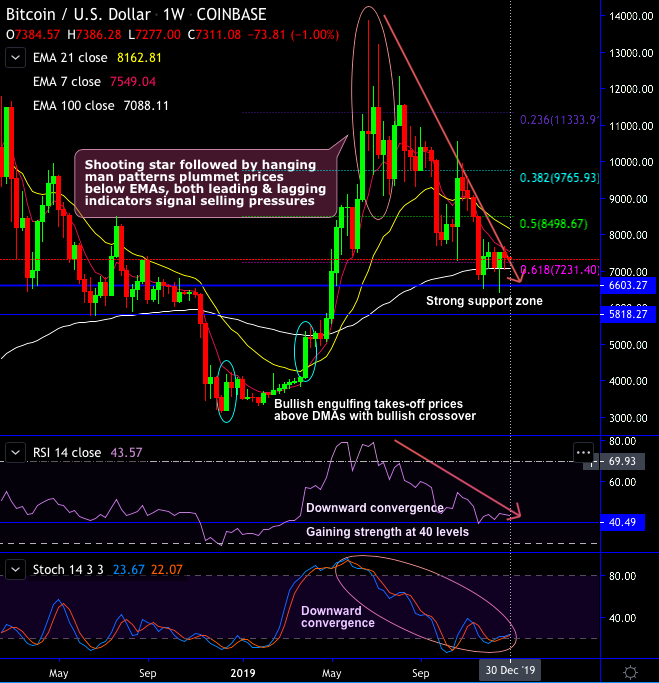Let’s just quickly glance at the underlying security price trend before we deep dive in to the hedging aspects of bitcoin.
BTCUSD (at Coinbase) is currently trading at around $7,360 levels (while articulating).
The year-2018 has been bearish rout for bitcoin price, during that phase, BTC price showed steep slumps and year-2019 has been mixed bag of sentiments, we could see no traces of slowing in its dominance as 2019.
At the beginning of the year, BTCUSD price surged from the lows of $3,337 to the year-highs of $13,868 levels (i.e. mammoth returns of 315 in percentage terms that too within a span of 6 months or so, refer above chart).
Although Year-2019 has been instrumental for bitcoin exchanges, crypto-traders and investors, it has been little turbulent. However, such robust uptrend has generated various price gaps in the CME Bitcoin futures contracts. The underlying price has also retraced 61.8% Fibonacci levels that has wiped off most of the gains in the year-2019.
Hence, hedging bitcoin has been crucial contemplating fundamental developments, it needs strategically establishing derivatives trades so that a gain or loss in the underlying exposure is offset by the changes to the value of the other position.
Usually, if one is prone to the risk factor associated with the open positions, then that should certainly be mitigated the risk either by reducing the position or by squaring it off or add some derivatives contracts to it.
However, hedging using derivatives is observed as a useful strategy for traders who want to maintain their original bitcoin holdings in the digital wallets offered by various exchanges.
At the moment, we have predominantly three derivatives methods through which the price turbulence of bitcoin can be arrested, namely:
1) CME’s & Bakkt’s Cash-Settled BTC Futures Contracts
2) Bakkt’s Physically-Settled BTC Futures Contracts
3) Bakkt’s Options Contracts
CME’s & Bakkt’s Cash-Settled BTC Futures Contracts: These Bitcoin derivatives are available on both Chicago Mercantile Exchange (CME) and ICE’s Bakkt that are traded and cash-settled contracts to enable clients to buy and sell Bitcoin at a predetermined price and predetermined date in the future. This arrangement facilitates investors to mitigate price risks in the specified future and settles in cash on the expiration. The price discounts that traders pay for Bitcoin at CME’s futures indicates the bearish sentiments despite mild recovery above $7k mark from the recent while ago. Hence, it also enables them to speculate with its price.
Bakkt’s Physically-Settled BTC Futures Contracts: We had CME BTC Futures so far, this facility is now available only on ICE-backed Bakkt who introduced this in last September. The listing of futures with physical delivery on a regulated exchange should serve to enhance the bitcoin market structure by allowing investors, particularly miners, to better hedge existing bitcoin exposures. This is because existing cash-settled futures may only allow for imperfect hedging as hedgers are susceptible to price risk associated with converting bitcoin to cash at maturity. And there is an issue of potential manipulation with cash-settled contracts as settlement is based on a collection of spot prices from a number of exchanges with variable liquidity, which traders may be able to manipulate around the time of the futures contracts expiry. These are European Style, Strike Prices are allowed in $250 increments, Contract Size is one bitcoin.
Strike Price Intervals: Strike prices will be listed in $500 strike intervals. The Exchange will always list a minimum of 10 strike prices above and below the at-the-money strike for any given Contract Period.
Bakkt’s Options Contracts: These are the first CFTC regulated option on futures contract for bitcoin, these contracts are based on the benchmark Bakkt Bitcoin (USD) Monthly Futures contract and settles into the underlying futures contract two days prior to expiry on ICE Futures U.S. Price discovery occurs completely within a federally regulated market and has no exposure to unregulated bitcoin spot markets.
In addition to these arrangements, we’ve got some OTC players who, like, BitMEX, OKEx and Binance who also offer such derivatives contracts which are unregulated but little risky.



 Bitcoin Defies Gravity Above $93K Despite Missing Retail FOMO – ETF Inflows Return & Whales Accumulate: Buy the Dip to $100K
Bitcoin Defies Gravity Above $93K Despite Missing Retail FOMO – ETF Inflows Return & Whales Accumulate: Buy the Dip to $100K  Citi Sets Bullish 2026 Target for STOXX 600 as Fiscal Support and Monetary Easing Boost Outlook
Citi Sets Bullish 2026 Target for STOXX 600 as Fiscal Support and Monetary Easing Boost Outlook  Indonesia Surprises Markets with Interest Rate Cut Amid Currency Pressure
Indonesia Surprises Markets with Interest Rate Cut Amid Currency Pressure  Bitcoin Bounces Hard: $87,592 Hit as Bulls Defend $80K – Next Stop $100K If $92K Breaks
Bitcoin Bounces Hard: $87,592 Hit as Bulls Defend $80K – Next Stop $100K If $92K Breaks  Bitcoin Reserves Hit 5-Year Low as $2.15B Exits Exchanges – Bulls Quietly Loading the Spring Below $100K
Bitcoin Reserves Hit 5-Year Low as $2.15B Exits Exchanges – Bulls Quietly Loading the Spring Below $100K  Global Markets React to Strong U.S. Jobs Data and Rising Yields
Global Markets React to Strong U.S. Jobs Data and Rising Yields  US Gas Market Poised for Supercycle: Bernstein Analysts
US Gas Market Poised for Supercycle: Bernstein Analysts  Asia’s IPO Market Set for Strong Growth as China and India Drive Investor Diversification
Asia’s IPO Market Set for Strong Growth as China and India Drive Investor Diversification  European Stocks Rally on Chinese Growth and Mining Merger Speculation
European Stocks Rally on Chinese Growth and Mining Merger Speculation  U.S. Treasury Yields Expected to Decline Amid Cooling Economic Pressures
U.S. Treasury Yields Expected to Decline Amid Cooling Economic Pressures 
































